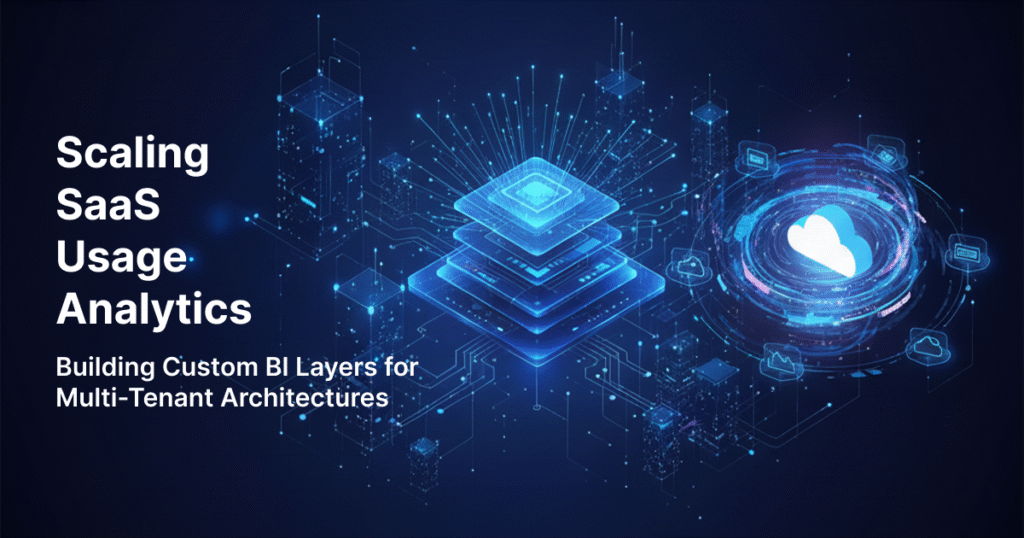In 2025, SaaS companies are no longer judged only by product features. They’re judged by how intelligently they surface insights to customers, stakeholders, and internal teams. As subscription models scale, usage visibility becomes not just a value-add but a strategic necessity.
This is where SaaS Usage Analytics takes center stage. For modern enterprises, raw logs and generic dashboards are no longer enough. The winners are those who build Custom BI Layers that scale across Multi-Tenant Architectures and deliver Enterprise BI Solutions capable of supporting diverse clients, industries, and compliance requirements.

Why SaaS Usage Analytics Matters in 2025
SaaS platforms now power finance, healthcare, retail, manufacturing, and beyond. But as adoption grows, so do questions:
Which features deliver the most business value?
How are different tenants using the product?
What patterns indicate churn risk or upsell opportunity?
How do usage patterns align with compliance and SLAs?
SaaS Usage Analytics addresses these by transforming raw activity into actionable insights. In 2025, SaaS providers are embedding analytics not just as dashboards but as core product differentiators. Customers increasingly expect self-service BI capabilities, tailored to their data.
The Challenge of Multi-Tenant Architectures
For SaaS providers, delivering analytics is far more complex than exposing log data:
Data Segregation
Multi-tenant systems must ensure strict isolation while enabling aggregated insights at the provider level.
Scalability
Thousands of tenants, millions of events, and growing complexity strain pipelines.
Customization Needs
Tenants demand reports that reflect their KPIs, not generic views.
Performance
BI queries should not slow down the core application.
Compliance & Security
Healthcare, finance, and government tenants require compliance-grade analytics — HIPAA, GDPR, SOC2 — baked into the data model.
Building Custom BI Layers for SaaS Usage Analytics
A Custom BI Layer bridges raw usage data and meaningful tenant-facing insights. Unlike generic dashboards, it provides tailored, secure, and scalable analytics capabilities.
1. Unified Data Ingestion
Centralize product logs, API calls, and metadata into a scalable warehouse (e.g., Snowflake, BigQuery). Stream processing ensures real-time SaaS Usage Analytics.
2. Multi-Tenant Data Models
Adopt data partitioning strategies:
Schema-per-tenant for maximum isolation.
Shared-schema with row-level security for scalability.
Hybrid approaches to balance scale with cost.
3. Transformation Pipelines
Use ELT frameworks to transform raw data into tenant-specific fact and dimension models. This enables both standard KPIs and tenant-customizable metrics.
4. Embedded BI Solutions
Provide analytics as part of the SaaS product itself. Modern Enterprise BI Solutions allow embedding charts, dashboards, and predictive insights directly in-app.
5. Customization Frameworks
Offer configuration layers so tenants can define:
Which KPIs matter
How dashboards are arranged
Who within their org gets access
This transforms analytics from one-size-fits-all to personalized intelligence.
Benefits of Custom BI Layers in SaaS Analytics 2025
Enhanced Customer Value: Tenants gain insights tailored to their workflows.
Revenue Growth: Usage analytics surfaces upsell opportunities (premium features, higher tiers).
Churn Reduction: Identify disengaged tenants early via usage drop-offs.
Operational Efficiency: Providers track infrastructure consumption to optimize cost.
Compliance Confidence: Audit-ready BI increases trust for regulated industries.
Guardrails for Scaling SaaS Usage Analytics
Performance Isolation
Keep analytical queries off production databases using replicas or warehouses.
Governance and Security
Apply row-level security, token-based access, and encryption to maintain compliance.
Cost Control
SaaS analytics at scale can be expensive. Monitor warehouse consumption and optimize queries.
Data Freshness SLAs
Balance real-time vs. batch refresh. Not every tenant needs second-by-second analytics.
Extensibility
Build the BI layer as a framework, not a feature. Future-proofing allows new metrics, AI-driven insights, and ML integration.
Research and Industry Trends
Gartner (2025) predicts that 70% of SaaS providers will offer embedded analytics as a differentiator.
IDC’s SaaS Analytics Outlook shows enterprises favoring vendors that provide self-service BI as part of the subscription.
Case Study: Salesforce & ServiceNow already use advanced SaaS Usage Analytics to drive both internal optimizations and customer-facing value.
McKinsey (2024) highlighted that SaaS vendors adopting Custom BI Layers saw up to 15% higher retention among enterprise tenants.
The Brigita.co Perspective
At Brigita.co, we believe SaaS providers can no longer treat analytics as an add-on. In SaaS Analytics 2025, BI must be embedded, customizable, and multi-tenant aware.
The future of Enterprise BI Solutions lies in three principles:
Scalable architectures that separate operational workloads from analytical queries.
Custom BI Layers that translate usage data into tenant-relevant KPIs.
Governance-first design that ensures compliance while unlocking insights.
Final Thoughts
The next competitive edge for SaaS companies will not be limited to product features. It will be defined by how well they deliver usage insights to customers and stakeholders.
Those who master SaaS Usage Analytics — powered by Custom BI Layers and designed for Multi-Tenant Architectures — will set the standard for Enterprise BI Solutions in 2025 and beyond.
The future isn’t just about delivering software. It’s about delivering intelligence at scale.
Search
Categories

Author
-
Keerthi Kumar A V is a backend developer in the early stages of his career, working with Django, Flutter, and interactive dashboards. Though new to the professional world, he is actively exploring vibe coding, AI-driven projects, and contributing to a solutions team. Curious and driven, Keerthi enjoys experimenting with coding projects, learning new technologies, and applying practical problem-solving to real-world challenges. He combines his passion for continuous learning with hands-on development, treating each project as an opportunity to grow and refine his skills.
